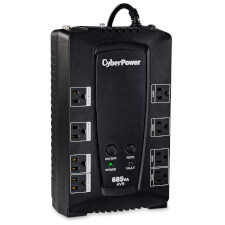UPS
Stands for "Uninterruptible Power Supply."
A UPS is a device that combines a surge protector and a high-capacity rechargeable battery. One can provide power to computers, broadband modems, Wi-Fi routers, and other devices during unexpected power outages. A typical UPS can power a desktop computer and monitor for up to 15 minutes (providing enough time to save files and safely shut down) or a modem and Wi-Fi router for several hours (to provide a wireless Internet connection). It can also provide temporary emergency power for other devices, including medical equipment like CPAP machines.
How much power a UPS can provide depends on its volt-amperes (VA) rating, which measures how fast the power inverter can convert battery energy into electric power. The maximum wattage is roughly 60% of the VA rating — a 900VA UPS can provide about 540W of power (give or take a few watts). Before buying a UPS, it's wise to know how much electricity your computer setup uses so that you get a powerful enough UPS.
UPS devices come in several form factors. Some look like standard surge protectors but are thicker to accommodate a battery. Others are upright and resemble small desktop computer towers. All UPS devices clearly label which power outlets connect to the battery backup and which are only surge-protected, so you know where to plug in the most important devices. Many also include USB-A and USB-C ports for charging mobile devices during a power outage.
Some UPS devices come with power management software to help your computer communicate with the UPS over a USB connection. If installed, this software can monitor the battery level and battery health of a UPS and show an estimate of how much time you have left. You can even configure it to automatically trigger a system shutdown when the battery is running low or notify you of a power outage via email.
 Test Your Knowledge
Test Your Knowledge